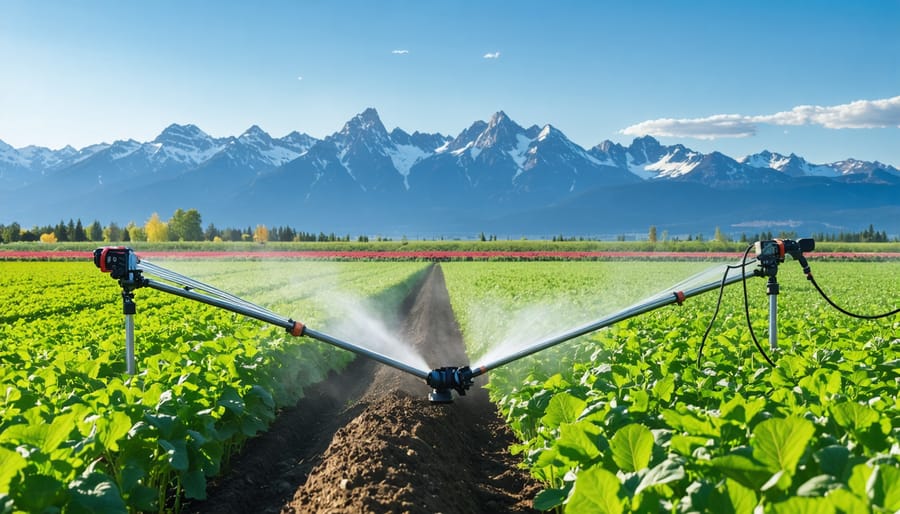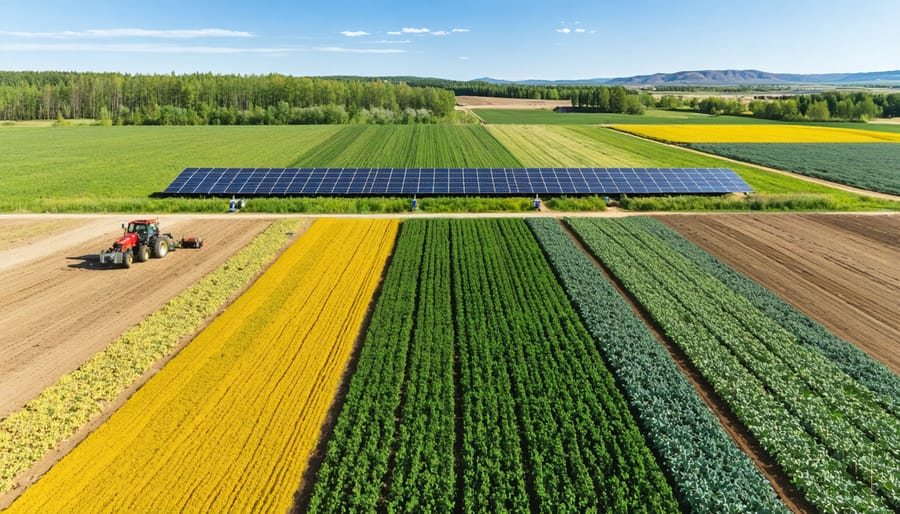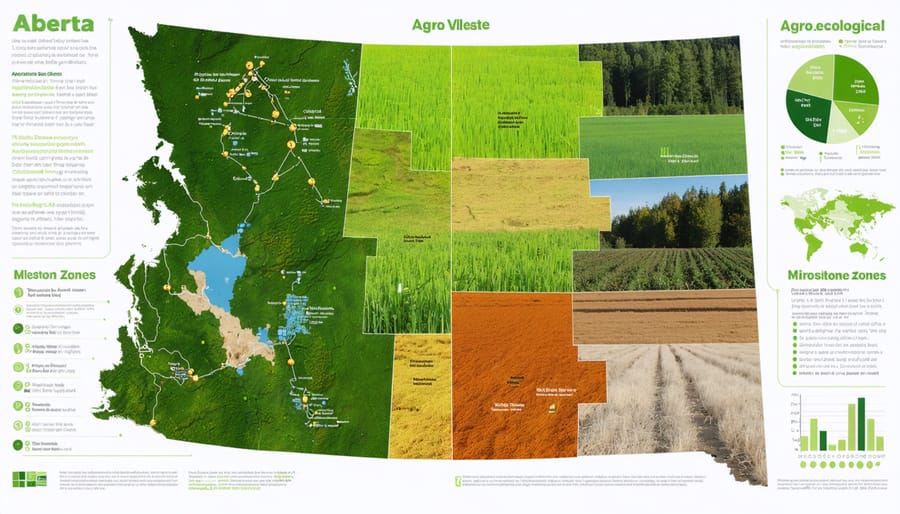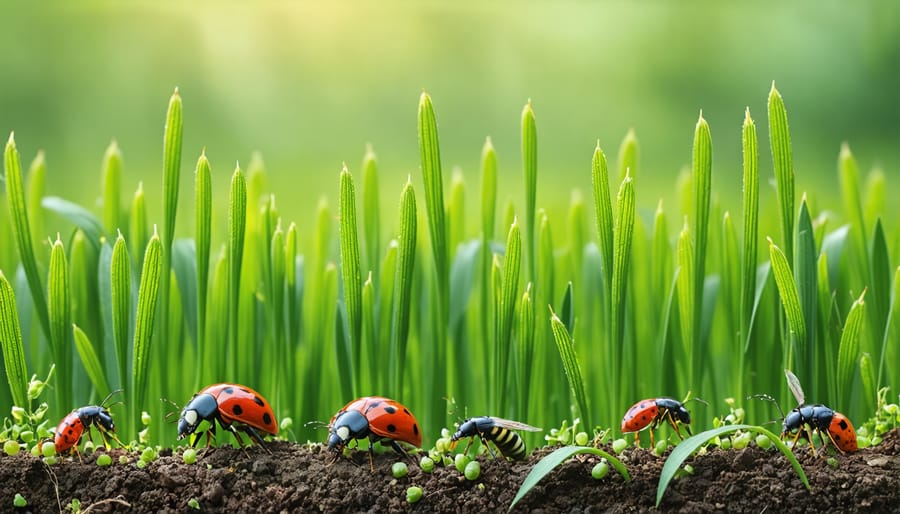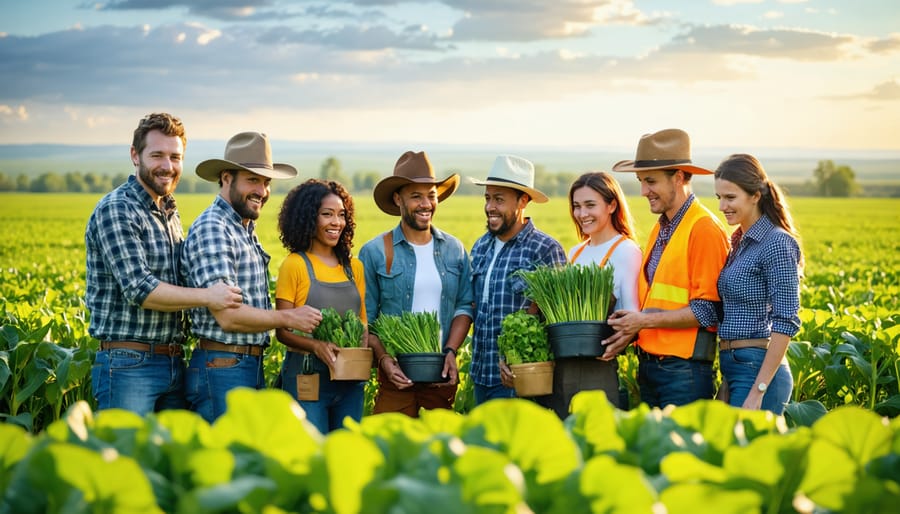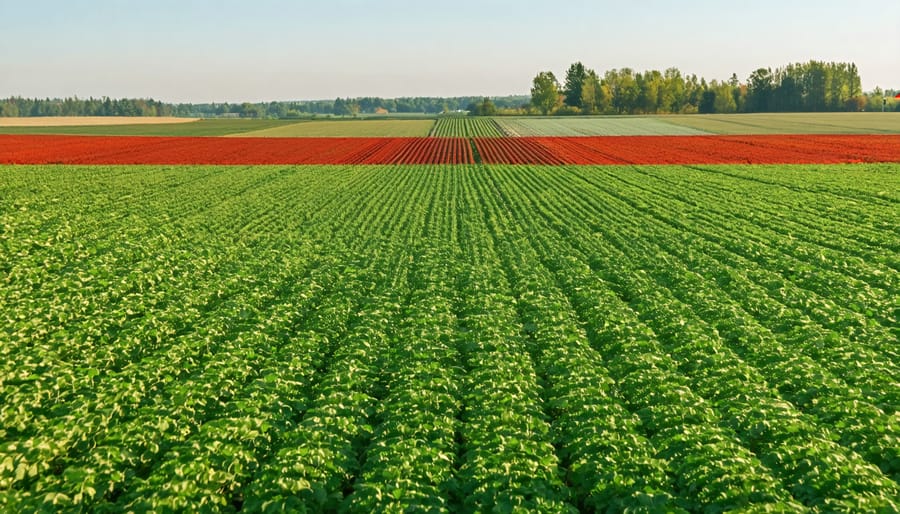Transform your farm’s water efficiency today through precision irrigation systems that are revolutionizing Alberta agriculture. Modern drip irrigation reduces water consumption by up to 70% compared to traditional sprinkler systems, while soil moisture sensors and weather-based controllers optimize water delivery to match exact crop needs. Smart irrigation scheduling, combined with drought-resistant crop selection, has helped Canadian farmers save an average of 45 million litres of water annually per operation. These water-efficient systems not only conserve our precious resources but deliver consistent yields even during challenging growing seasons – a critical advantage for Prairie farmers facing increasingly unpredictable weather patterns. With government rebates covering up to 40% of installation costs and typical ROI within 2-3 growing seasons, upgrading to water-efficient irrigation represents a practical solution for sustainable farm management. Our local success stories demonstrate that precision irrigation technology, when properly implemented, can reduce operational costs while maintaining or improving crop quality across Alberta’s diverse agricultural landscape.
The Real Cost of Traditional Irrigation in Alberta
Water Usage Statistics in Alberta Agriculture
Alberta’s agricultural sector currently accounts for approximately 64% of the province’s total water consumption, with irrigation being the primary use. Recent data from Alberta Agriculture and Forestry shows that the average farm uses between 300-400 millimetres of water per hectare during the growing season, though this varies significantly by crop type and location.
In southern Alberta, where most of the province’s irrigation districts are located, farmers manage roughly 680,000 hectares of irrigated land. Over the past decade, water use efficiency has improved by nearly 30% through the adoption of modern irrigation technologies. However, studies indicate that an additional 20-25% reduction in water consumption is achievable through further system upgrades.
The South Saskatchewan River Basin, which supplies water to about 80% of Alberta’s irrigated agriculture, has seen increasing pressure on its resources. This has motivated many farmers to explore more efficient irrigation solutions, with pivot systems and drip irrigation leading the transition toward sustainable water management.
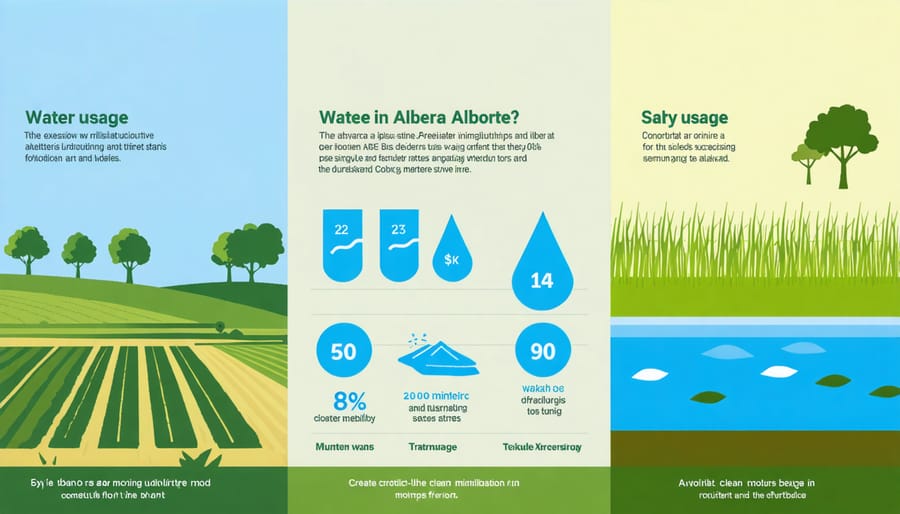
Climate Impact on Water Resources
The climate challenges facing Alberta farmers have made water management increasingly crucial for successful crop production. Rising temperatures and unpredictable precipitation patterns are reshaping how we approach irrigation across the prairies. Recent data shows that Alberta experiences 15-20% more variable rainfall than in previous decades, creating a pressing need for adaptive irrigation strategies.
Our changing climate brings both challenges and opportunities. While some regions face extended dry spells, others experience intense rainfall events that can overwhelm traditional irrigation systems. These shifts require farmers to adopt more responsive and efficient irrigation methods. For instance, many producers in Southern Alberta have noticed longer growing seasons but with more erratic moisture availability, making precise water delivery systems essential.
By understanding these weather patterns and implementing water-efficient irrigation, farmers can better prepare for seasonal variations while conserving our precious water resources.
Modern Water-Efficient Systems That Work in Canadian Conditions
Drip Irrigation Systems
Despite Alberta’s challenging climate, drip irrigation systems have proven remarkably effective when properly winterized and maintained. These systems deliver water directly to plant roots through a network of tubes and emitters, reducing water usage by up to 70% compared to traditional sprinkler systems.
For cold-climate operations, we’ve seen successful implementations using heavy-duty polyethylene tubing that resists freeze damage. Local farmer Sarah Thompson from Lethbridge notes, “Since switching to drip irrigation three years ago, we’ve cut our water consumption in half while improving our crop yield by 30%.”
The key benefits for Alberta farmers include precise moisture control, reduced weed growth, and decreased soil erosion. Installation costs typically range from $2,500 to $4,000 per hectare, but government rebates through the Canadian Agricultural Partnership can offset up to 30% of these costs.
To ensure longevity in our climate, proper winterization is crucial. This involves draining the system completely before the first freeze and using compressed air to clear residual water from lines. Many Alberta farmers combine drip systems with mulch coverage, which provides additional insulation and further reduces water evaporation.
For best results, consider starting with a small test plot before expanding. The Alberta Irrigation Technology Centre offers free consultations to help farmers design systems tailored to their specific soil conditions and crop requirements.
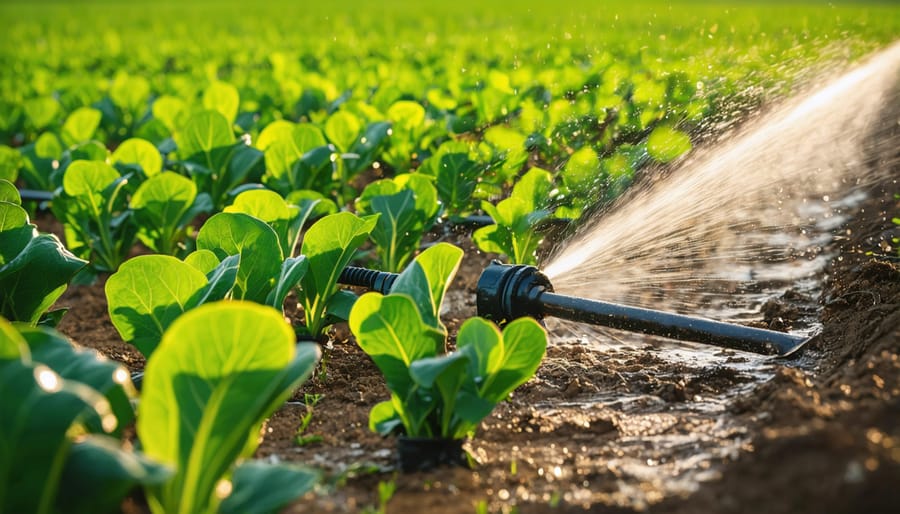
Smart Sprinkler Technologies
Modern smart sprinkler technologies have revolutionized how Alberta farmers manage their irrigation systems. These advanced systems combine weather monitoring capabilities with precision control, helping you make the most of every drop of water while maintaining optimal crop health.
At the heart of smart sprinkler systems are weather stations that continuously monitor local conditions including temperature, humidity, wind speed, and precipitation. This real-time data helps determine exactly when and how much to water your crops. For instance, if rain is forecasted, the system automatically adjusts or postpones scheduled irrigation, preventing water waste.
Many Alberta farmers have found success with soil moisture sensors that work alongside these weather stations. These sensors, placed at various depths in your field, provide accurate readings of soil moisture content, typically measuring in kilopascals (kPa) or percentage of water content. This data ensures irrigation occurs only when truly needed.
Smart controllers are another game-changing feature, allowing you to manage your irrigation system remotely through smartphone apps. You can adjust watering schedules, monitor system performance, and receive alerts about potential issues, all from the palm of your hand. Some systems even integrate with local weather services to create dynamic watering schedules based on seasonal changes and weather patterns.
These technologies have shown impressive results in our province, with many farmers reporting water savings of 30-50% compared to traditional irrigation methods while maintaining or improving crop yields.
Soil Moisture Sensors and Automation
Modern soil moisture sensors have revolutionized irrigation practices across Alberta’s farmlands, offering precise control over water application. These smart devices monitor soil moisture levels in real-time, helping farmers make data-driven decisions about when and how much to irrigate their crops.
The most common types used in Canadian agriculture include capacitance probes, which measure water content through electrical charges, and tensiometers, which gauge soil water tension. When connected to automated irrigation controllers, these sensors create a responsive system that activates only when crops truly need water.
Local farmer Mike Thompson from Lethbridge shares, “Since installing moisture sensors across my 400-hectare farm, I’ve reduced water usage by 30% while maintaining crop yields. The system alerts me through my smartphone when soil moisture drops below optimal levels.”
Integration is straightforward: sensors are typically placed at different soil depths and strategic field locations, providing a comprehensive moisture profile. Modern systems can be paired with weather forecasting data to prevent unnecessary irrigation before predicted rainfall.
The initial investment in sensor technology often pays for itself within two growing seasons through water savings and improved crop health. Many irrigation districts in Alberta offer rebate programs for farmers implementing these water-efficient technologies, making the transition more accessible for operations of all sizes.
For best results, experts recommend combining moisture sensors with regular soil testing and crop-specific moisture thresholds, creating a holistic approach to water management.
Real Results: Alberta Success Stories
Southern Alberta Grain Farm Transformation
The Henderson family farm, located 30 kilometers east of Lethbridge, stands as a testament to successful future-proofing grain production through innovative irrigation practices. In 2019, third-generation farmer Mark Henderson transitioned from traditional pivot irrigation to a precision drip system across 320 hectares of wheat and canola fields.
The transformation began with a comprehensive soil mapping project, followed by the installation of subsurface drip lines at 40-centimeter depth. The system includes soil moisture sensors every 100 meters and weather monitoring stations that provide real-time data to Henderson’s smartphone app.
Results were remarkable within the first growing season. Water usage decreased by 40% compared to previous years, while crop yields increased by 27%. Energy costs for pumping dropped significantly, and the farm’s water efficiency rating improved from 65% to 92%.
The project required an initial investment of $425,000, with 30% covered by provincial agricultural grants. Henderson reports that the system paid for itself within three years through reduced input costs and improved yields. The farm now serves as a demonstration site for the Southern Alberta Irrigation Project, hosting regular field days where local farmers can learn about precision irrigation technology.
What makes this case particularly noteworthy is the system’s adaptability to varying weather conditions and soil types, proving that modern irrigation solutions can work effectively in Alberta’s unique agricultural landscape.
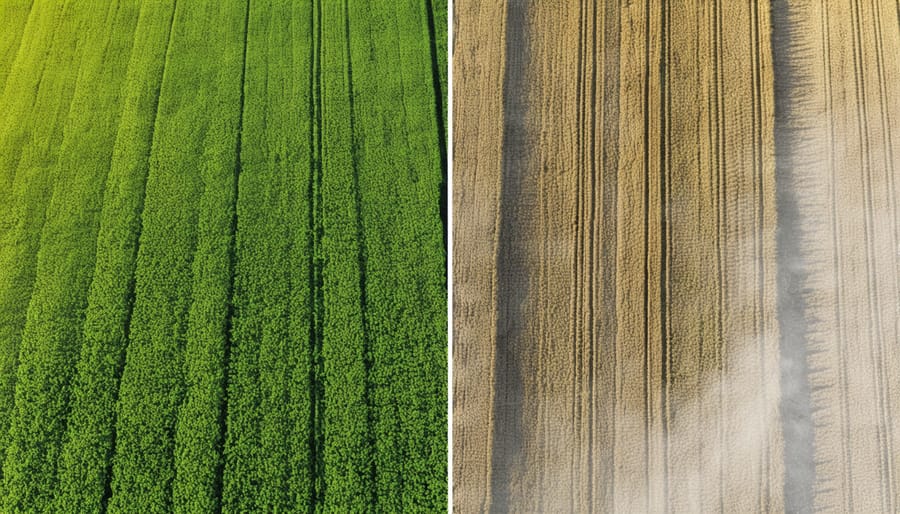
Market Garden Water Optimization
When Sarah Mitchell transformed her 2-hectare market garden in Lacombe, Alberta, into a model of water efficiency, she didn’t expect to become a local inspiration. By implementing a combination of drip irrigation and soil moisture sensors, she reduced her water consumption by 45% while increasing crop yields by 30% in just two growing seasons.
“The key was starting small and scaling up gradually,” Mitchell explains. “We began with a quarter-hectare test plot using drip lines for our tomatoes and peppers. The results were so impressive that we quickly expanded the system to cover our entire operation.”
Mitchell’s success stems from careful planning and collaboration with local agricultural extension services. She installed pressure-compensating drip emitters that deliver water directly to plant roots, dramatically reducing evaporation losses. The system’s timer-controlled operation allows for precise water delivery during early morning hours when evaporation rates are lowest.
The project’s total cost of $12,000 was offset by water savings and increased produce quality. Local retailers now pay premium prices for Mitchell’s vegetables, noting their consistent size and improved shelf life. The system paid for itself within 18 months.
Most importantly, Mitchell’s water-efficient setup proved resilient during the 2021 drought, maintaining production while many conventional gardens struggled. She now hosts monthly workshops for other market gardeners, sharing her experience and helping build a more water-conscious farming community in central Alberta.
Implementation Guide: Getting Started
System Selection and Planning
Selecting the right irrigation system for your farm requires careful consideration of several key factors. Your soil type, crop selection, field topography, and available water sources all play crucial roles in determining the most effective solution.
For Alberta’s diverse agricultural landscape, drip irrigation systems often prove ideal for row crops and orchards, offering up to 95% water efficiency. Centre pivot systems, while requiring more initial investment, work well for larger fields of 40 hectares or more, particularly for cereals and forage crops.
Consider your farm’s unique characteristics when planning. Heavy clay soils might benefit from slow-release drip systems, while sandy soils may require more frequent irrigation cycles. Your local weather patterns and seasonal rainfall should also influence your choice – many Alberta farmers find success with hybrid systems that combine different irrigation methods for optimal efficiency.
Budget planning should account for both immediate and long-term costs. While modern systems like precision sprinklers might have higher upfront costs, they typically offer better returns through reduced water usage and increased crop yields. Many Canadian agricultural programs offer grants and incentives for implementing water-efficient irrigation systems.
Consult with local irrigation specialists and fellow farmers who have experience with different systems. Their practical insights can help you avoid common pitfalls and make informed decisions based on real-world results in similar conditions.
Remember to factor in future expansion plans and potential crop rotations when selecting your system. A flexible design that can adapt to changing needs often proves most valuable in the long run.
Available Resources and Support
Alberta farmers have access to numerous resources and support programs to help implement water-efficient irrigation systems and boost profits through sustainable practices. The Canadian Agricultural Partnership (CAP) offers grants covering up to 50% of eligible costs for irrigation system upgrades, with maximum funding of $100,000 per project.
Local irrigation districts provide technical assistance and consulting services, helping farmers assess their current systems and plan improvements. The Alberta Irrigation Technology Centre offers hands-on demonstrations and training programs throughout the growing season, allowing farmers to learn about the latest water-efficient technologies in practical settings.
The Agriculture Financial Services Corporation (AFSC) provides low-interest loans specifically designed for irrigation system improvements. These loans feature flexible repayment terms and competitive rates to make modernization more accessible.
For technical support, the Irrigation and Farm Water Division of Alberta Agriculture and Forestry maintains a network of specialists who offer free consultations and system evaluations. They can help farmers optimize their irrigation scheduling and equipment selection.
Additionally, several agricultural equipment dealers across Alberta offer specialized training and after-sales support for modern irrigation systems, ensuring farmers can maximize the benefits of their investments. Many also organize regular workshops and field days where farmers can network and share experiences with peers who have successfully implemented water-efficient systems.
As we’ve explored throughout this article, water-efficient irrigation systems are not just an environmental choice – they’re a smart business decision for Canadian farmers. By implementing these advanced irrigation methods, Alberta’s agricultural community can significantly reduce water consumption while maintaining or even improving crop yields. The success stories we’ve shared from local farmers demonstrate that the initial investment in modern irrigation technology pays off through reduced operating costs and increased productivity.
Remember, every farm is unique, and there’s no one-size-fits-all solution. Whether you choose drip irrigation, precision sprinklers, or soil moisture sensors, the key is to start with a thorough assessment of your specific needs and conditions. Take advantage of the resources and support available through local agricultural extension services and irrigation specialists who understand Alberta’s unique growing conditions.
As water becomes an increasingly precious resource, making the switch to water-efficient irrigation isn’t just about staying competitive – it’s about ensuring the sustainability of Canadian agriculture for generations to come. Take that first step today by reaching out to local irrigation experts or connecting with fellow farmers who have already made the transition. Your farm’s future may depend on it.

